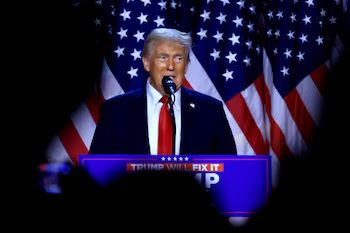The growing presence of Chinese companies in Mexico is raising alarms in Washington and threatening to reshape North American trade.
In 2018, US President Donald Trump initiated a trade war with China. Mexico benefited as companies sought to avoid tariffs by diversifying production away from China, thanks to its affordable labor, decent infrastructure, and crucially, its free trade agreement with the United States.
However, as Trump’s second term approaches, this logic is unraveling. Chinese companies have increasingly turned to Mexico, significantly boosting their investments. Trump, who has threatened a 25% tariff on Mexican imports unless Mexico curbs illegal migration and drug trafficking, believes these companies are using Mexico as a tariff-free gateway to the US. This conviction could potentially dismantle the United States-Mexico-Canada Agreement (USMCA).
Concerns about Chinese activity in Mexico are bipartisan and longstanding. In 2019, US officials feared Chinese exporters were using Mexico as a conduit to the US market, particularly for steel and aluminum. This issue has been largely addressed by Mexico imposing tariffs on these metals from China and establishing a “smelt and pour” rule, requiring steel to be “substantially transformed” in Mexico before export to the US. Outright fraud, where products imported from China are labeled as made in Mexico and then exported to the US, is likely rare.
Today, the focus is on Chinese companies assembling or manufacturing products in Mexico for sale in the US. By 2023, Mexico surpassed China as the leading exporter of goods to the US, while Chinese exports to Mexico have grown significantly. In 2002, Mexican exports to the US contained less than 5% Chinese components by value. By 2020, this figure had risen to 21%.
Electric vehicle (EV) production is a major issue. Most EVs sold globally are made in China, generally at a lower price and with equivalent or higher quality than those produced by American companies. In September, President Joe Biden raised tariffs on EV imports from China to 100%; without these tariffs, sales would skyrocket. However, these taxes do not apply to vehicles made in Mexico.
Trump claims Chinese automakers are building “huge” factories south of the border. This is false. Only one Chinese joint venture produces EVs for the Mexican and regional market. BYD, China’s leading EV maker, announced plans to build a factory in Mexico capable of producing 150,000 vehicles a year, but this project has not yet materialized. This month, Solarever, a smaller manufacturer, announced it would build a plant in northern Mexico.
Chinese companies are expanding further down the supply chain. In 2018, there were eight Chinese auto parts manufacturers in Mexico. By the end of 2023, there were at least 20, producing trim, battery casings, and high-tech items like driver-assistance software. Many vehicles made in Mexico with Chinese components meet the USMCA requirement that 75% of a car be produced in Mexico to qualify as tariff-free. But even if it is legal, says Joshua Meltzer of the Brookings Institution, “Political tolerance for China is declining.” Anything with even a hint of a connection to China is viewed with suspicion. “Made by China is the new Made in China,” says Jorge Guajardo, former Mexican ambassador to China.
Today, the free trade guaranteed by the USMCA is subordinated to concerns about China, says Enrique Dussel Peters, director of the China-Mexico Studies Center at the National Autonomous University of Mexico (UNAM). This issue weighs on the agreement’s review scheduled for 2026. In September, Marco Rubio, Trump’s nominee for secretary of state, warned of China’s “rampant exploitation of Mexico as a middleman” and its “manipulation of the USMCA.” Canadian politicians have suggested expelling Mexico from the USMCA and negotiating a bilateral free trade agreement.
Mexican officials argue that the focus on Chinese investment in Mexico is hypocritical; Chinese foreign direct investment (FDI) in Mexico is small compared to the billions China invests annually in the US. Yet in Mexico, Chinese FDI has grown dramatically, while its investment in the US has declined. Mexico’s official FDI figures appear to underestimate Chinese investment by a factor of six, according to the Rhodium Group, which estimates $13 billion has been invested since 2013. Mexico is paying the price for “being slow to read the signals,” says one American diplomat.
Mexican President Claudia Sheinbaum has taken note. Her government is moving quickly to please its northern neighbor, establishing a body to evaluate foreign investments, modeled after those in the US and Canada. It also plans to replace components imported from China with those made in Mexico. Economy Secretary Marcelo Ebrard says Mexico must start making microchips and lithium batteries. Other measures to curry favor with Trump are coming quickly. “Mexico wants to be part of the team with Canada and the United States,” says Luis Rosendo Gutierrez, an official at the economy ministry.
But the debate is disconnected from the reality of trade complexity, says Dussel Peters. Foreign companies in Mexico, predominantly American, account for 70% of exports to the US. American automakers like General Motors and Ford have integrated Chinese companies into their supply chains, even encouraging Chinese suppliers to set up shop in Mexico.
Import substitution takes time and requires incentives. The Mexican government, with limited resources, cannot offer the subsidies available in the US for domestic production of chips and batteries. Some inputs simply cannot be sourced outside China. “We have not developed supply chains in the region for inputs like electric vehicle batteries,” explains Odracir Barquera of the Mexican Automotive Industry Association.
Meanwhile, Mexico has another concern. In the early 2000s, it lost ground to China in exports to the US. Now, if Chinese companies begin to displace Mexican companies in North American supply chains, Mexico will suffer again, says Margaret Myers of the Inter-American Dialogue.
On this point, US and Mexican officials agree. “The message to the United States is: ‘How do I help you manufacture what you import from Asia?’” Gutierrez says. “Because that will help us, too.”
Source: Infobae




